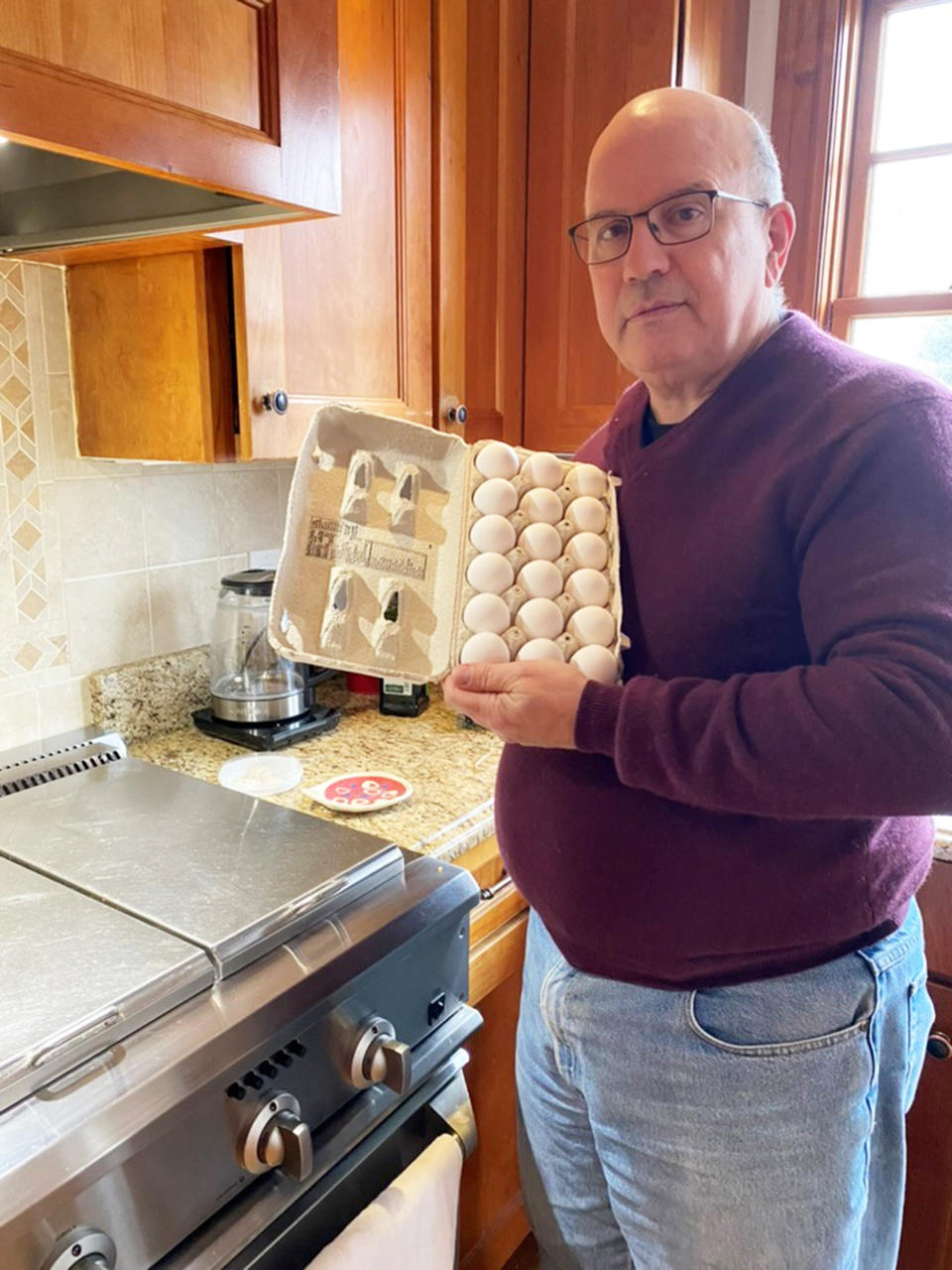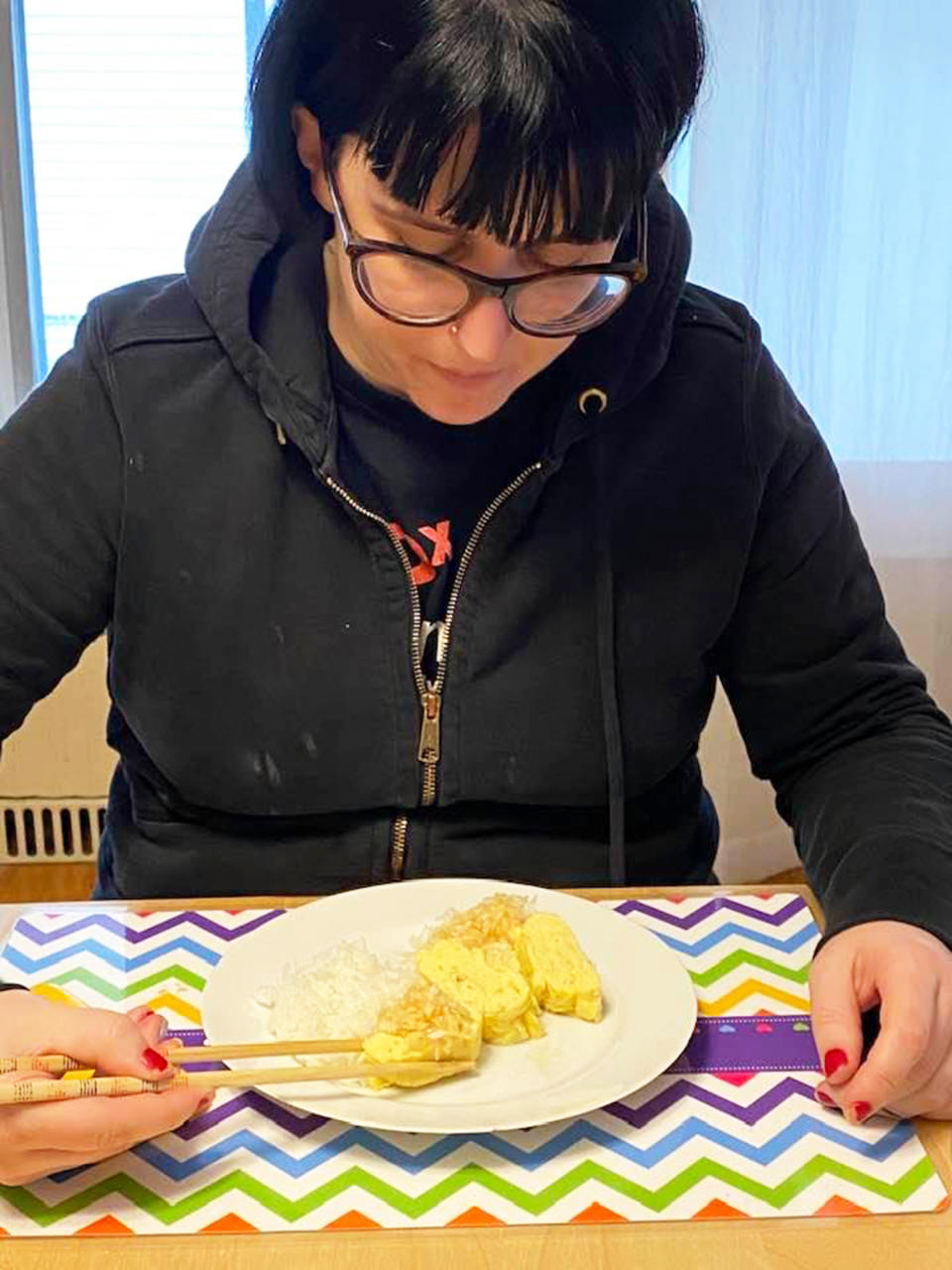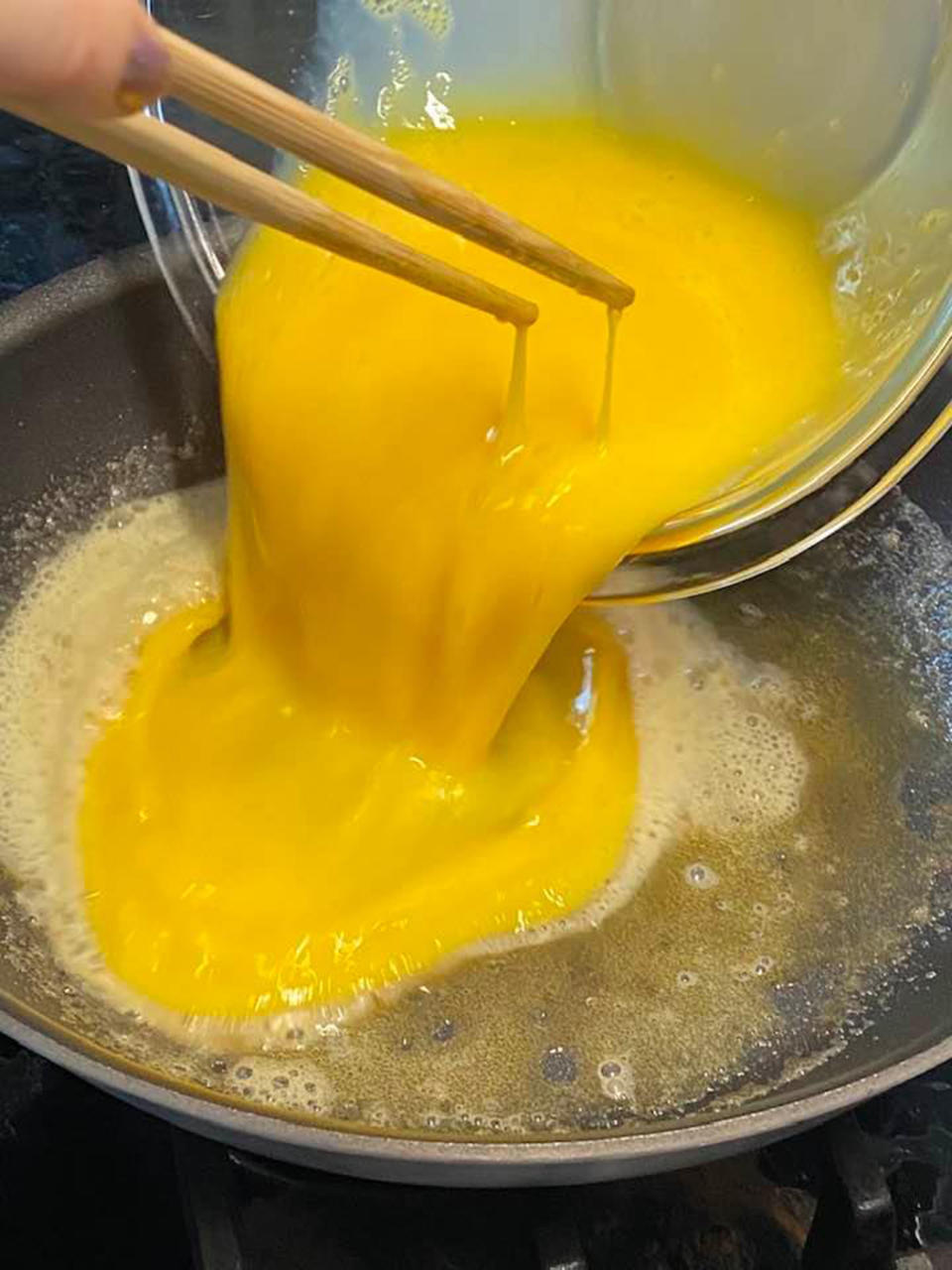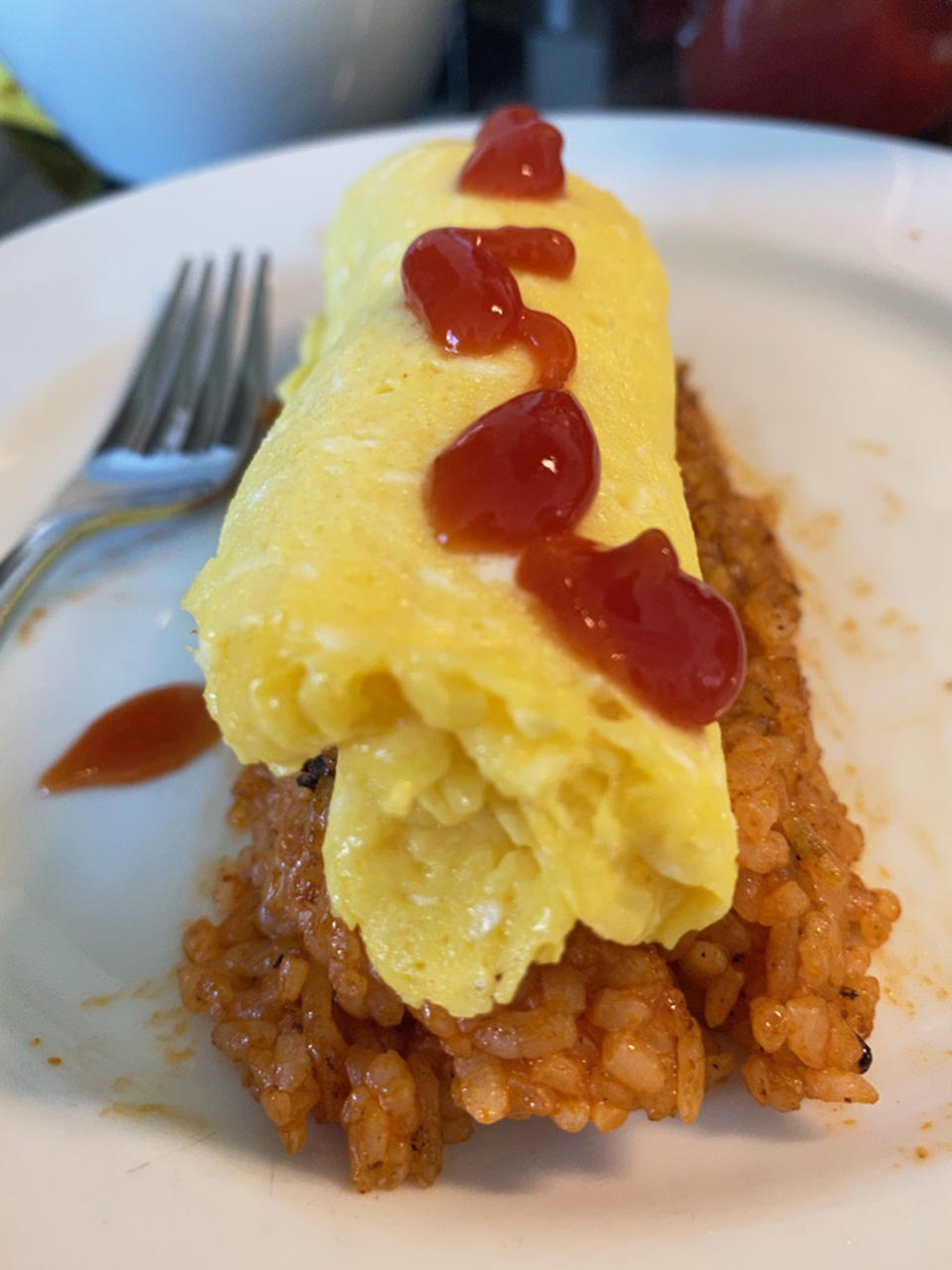My dad taught me persistence through omelets. Yes, omelets
I enjoy many egg dishes, but I prefer a single egg texture — custardy. Soft, a little gooey, bordering on runny, velvet on the tongue. For me, a classic French omelet — a thin skin of cooked egg wrapped around a custardy scramble, egg containing egg neatly in its own self-envelope — is the ultimate egg dish. Though the egg man himself, Jacques Pépin, once told me he was in the mood for a “large curd country omelet for dinner” that night, the classic French omelet is still his favorite preparation.
The question of how to make an ideal omelet is one for the ages.
Believe me when I say that over the last quarter century my dad and I have made omelets with the best of them. We have tried one-, two-, three-, even eight-egg omelets. We have tried 12 different kinds of pans. We have tried many different garnishes, from cheese and herbs to smoked haddock and hollandaise (omelet Arnold Bennett). We have tried gas flame and electric heat, blazing pans yanked on and off the burner, as well as cooler ones resting over a low flame, eggs beaten with fork, chopsticks, whisk and spatula. We have tried plain eggs, eggs with salt, eggs with salt and Tabasco, eggs diluted with water and milk, even herbs and fried breadcrumbs beaten right into the mixture.

We still cannot make a perfect classic French omelet every time, and frankly that is part of the omelet’s appeal. My dad explains why he keeps on trying: “My interest in omelets grew because they are hard to make correctly. If I could make one right every time, I’d probably be less interested in them. But I have tunnel vision and a little bit of a perfection neurosis.” Only a master can make one perfectly every time, and Jacques is a master, undoubtedly. And though we have watched his nimble hands turn out omelet after omelet, picked up on this or that aspect of his technique, it is still no substitute for practice. I can only conclude that Jacques has brains in his hands, a chef’s finely honed sense of exactly how eggs behave.
And yet the precariousness of the omelet, the fact that we get it perfect only one out of every five times, adds to the charm. As my dad says, “What you are doing is ephemeral — you make an omelet, and you eat it and then what you have is the memory. You can’t put it under glass and say I did that; you have to say I ate that.” Omelets are evanescent; to make a fine one is to master the variables of heat, arm motions and additives, and play them against one another in exactly the right manner. Each omelet is its own little art happening — here today and gone in a gulp.
While I have many memories of making omelets, I have few of eating them. Everything runs together in one bite of buttery, eggy goodness. After I moved out of the house, though, I used my omelet pan — the trusty carbon steel one my dad gifted me before college — to run workshops for my friends, and these, plus the lessons from my dad, are what I remember. Psychologist Mihaly Csikszentmihalyi first described the concept of flow in the book of the same name, and for me, an omelet workshop produces many of its hallmarks. A person achieves flow when immersed in a task that is challenging but not beyond their skill, intrinsically rewarding, and structured to make progress visible. All of these describe omelet making. Achieving perfection is tricky, practice inevitably nets improvement, and almost all results taste delicious. Improvement comes from keen attention to all the senses: touch — the fork that jumbles up the egg as soon as it hits the heat, the weight of the pan you jerk back and forth until the crucial decision to let it set; sound — the egg’s sizzle in hot but not too hot butter, your friends yelling advice at you; sight — the pan you jerk back and forth until the crucial decision to let it set when you can see the curds are just so; smell — buttery, not browned; and taste — rich and custardy.
During one workshop in a vacation rental, perhaps five of us crowded around two pans on the stove, feeding our successes and failures to the crowd on the porch. Two hours and four dozen eggs later, we stopped because my friend, culinary experience designer Avital Ungar, made the perfect French omelet. We stared at it with pleasure, congratulating her on the pale, tender, buttery goodness. The chefs saved that one for themselves.

My younger cousin Kitt, who loved to cook, lived with my parents for his last year of high school. He also received omelet lessons from my dad — a sort of brotherhood of the pan. My dad, of course, gave him a carbon steel skillet as a parting gift for college. When I was in my early thirties, Kitt, then nineteen, skied into a tree and died. Our family was beyond devastated. A few afternoons after the tragedy, some friends came over to keep me company. It felt so natural to queue up a series of instructional videos, retreat to the kitchen, and work through a stack of eggs. I remember laughing together, feeling Kitt’s presence among us, as my husband came home with supplementary supplies. One of us held a golden mandorla on a plate, and all four of us reached forks forward simultaneously.
My practice, but not perfection, of the classic French omelet has convinced me that those who master the egg are magical. It is easy to mistake equipment for skill, my dad explains, and that is why he has a veritable museum of omelet pans, more than a dozen. On a video call, he spreads them all out for me: three reproductions of Julia Child’s favored pan, made of old torpedo shell ends; the aluminum Mr. Omelet pan he and his sisters gave their father in the 1960s; a bookend of cast-iron pans, the first purchased for himself as a young college student, the second a special antique pan with a smooth milled bottom, purchased on retirement from tax lawyering; and what, by his accounting, was the holy grail of pans — blue French steel, which is really a romantic way of saying carbon steel that stains. Cheap and indestructible, they are the traditional choice for making a classic French omelet. Like cast-iron, blue steel pans require seasoning — the gradual buildup of a patina of oil, polymerized by heat. I have the twin to his eight-inch carbon steel pan in my cupboard, with my own slowly growing museum of omelet gear.
My mother wandered into the frame, and before she could see the kitchen, my father placated her with “I’ll put all those pans back when I finish talking to Lizzie.” She muttered something about needing a blindfold instead of a face mask, but after forty years of marriage, she’s resigned to the culinary overkill. Some men retire and start gambling or buying sportscars, she once told me, but all my dad wants is omelet pans. And trumpets, but that’s for another book.
Why so many omelet pans? It has to do with the proximity to greatness. Take Jacques, my dad says. “You look at the equipment that he is using and say, ‘I wanna be like him and all I need is that pan,’ when in fact he could probably do the same thing with a stick over the fire. So you can be kind of an omelet pan-o-holic because it’s really hard to get an omelet just right. You put it on, and unless you’ve done it so much that you speak the language of eggs and can hear what they are saying, you’re f-----. So if you can’t speak omelet, can’t have a dialogue with the egg, the next best thing is to go and get the next pan.” A poor carpenter blames his tools and all that, but sick gear is its own inducement.
I have a vendetta against nonstick. When I was 16, a scratched nonstick pan imparted the flavor of old salmon oil into an otherwise perfect omelet. For years, I have been saying that they are b-------, part of the American movement of planned obsolescence. Nonstick pans scratch, but carbon steel is forever. And yet. Nonstick technology has apparently advanced over the past few decades, and it was the choice of pan for the two chefs whose advice I venerate. Kenji makes omelets on nonstick, and so does Jacques. Who are we to argue?

So my dad and I added to our omelet pan collections yet again. And I confess I have done a 180. I was attached perhaps to the romance and sheer difficulty of a steel pan, but the nonstick is foolproof. I simply changed out my omelet-making fork for some wooden chopsticks, and whether the heat is super low, low or medium low, voilà! I turn out perfectly creamy and pale specimens every time.
I cannot get enough of the classic French omelet. But I don’t prefer it in a classic way, at least not a French classic way, with cheese or herbs. I prefer it as made by the gang of vagabond chefs in the classic 1985 food film "Tampopo," which centers on the relationship between people and food in modern Japan. This delightful film takes its inspiration from Westerns and kung fu movies, so naturally it’s about a cowboy truck driver who decides to train a single mom to become the best ramen chef in the land. Cue the training montage, which involves lifting a lot of stock pots. Its B story involves a gangster and his girlfriend’s erotic explorations with food: a memorable scene includes them getting intimate while passing a raw egg yolk between their lips. It also has a few short segments loosely based around food themes. In one of them, the cowboy takes our heroine to meet the gang of vagabond chefs who hang out behind the city’s best restaurants and finish all the fancy, half-drunk wine bottles. While she’s there learning about wine, one of the vagabonds absconds with her kid to make him a snack. Silently, to Charlie Chaplin music, they sneak into a commercial kitchen while avoiding its security guards.
The boy’s mouthwatering prize is a perfect French omelet perched atop a mound of rice that has been stir-fried with ketchup. The vagabond slices down the middle of the omelet to reveal its gooey interior, then tops it with more ketchup. It glistens with promise. And since Japan is very far away, and more elaborate versions of this dish (called omurice) on YouTube were years off, my father and I rewatched the scene nine or 10 times and headed to the stove. This is still my very favorite omelet. The jagged texture and tang of the ketchup rice play against the eggs’ creaminess. The added ketchup on top has its own different pudding texture, lighter and thinner than the unctuous egg. Tomato and eggs are, after all, a classic combo, both in French cuisine and in Chinese cuisine, where stir-fried tomatoes and eggs are among the first dishes kids learn to cook. I am fond of the Chinese fry-up, but nothing can replace omurice in my heart. Part of the romance lies in the flavors and textures, but it also lies in my memories of watching that niche film with my dad, then using our wits to concoct our own version.

My dad’s obsession with the perfect omelet comes from his mother, a farm girl who raised chickens. She was meticulous and insisted that everything get done the right way, aka her way, no matter how long it took. It also comes from my dad’s father, who grew up the eldest of seven children in an impoverished upstate New York home. He went to technical college on the GI Bill — the first in his family to finish this level of schooling — and became an engineer who designed drone planes to fly around H-bomb tests taking measurements. For my grandpa, who grew up in poverty, food, particularly fancy food, could be a supreme adventure. One year for Christmas he wanted to try roast suckling pig but famously brought home an enormous yearling, frozen, with legs extending fore and aft. It required a hacksaw to get it into the oven. He also made real Danish pastry with my dad after reading about it in a glossy magazine and once organized a shipment of live lobsters from Maine with some of his colleagues at the air base. My dad brings his father’s sense of adventure to our investigations, as well as his mother’s sense of precision. And he has imbued that sense of adventure in me, which has brought us our eggy obsession.
TODAY independently determines what we cover and recommend. When you buy through our links, we may earn a commission. Learn more.

Eggcerpted from "Egg: A Dozen Ovatures" by Lizzie Stark. Copyright © 2023 by Lizzie Stark. Used with permission of the publisher, W. W. Norton & Company, Inc. All rights reserved.
This article was originally published on TODAY.com

